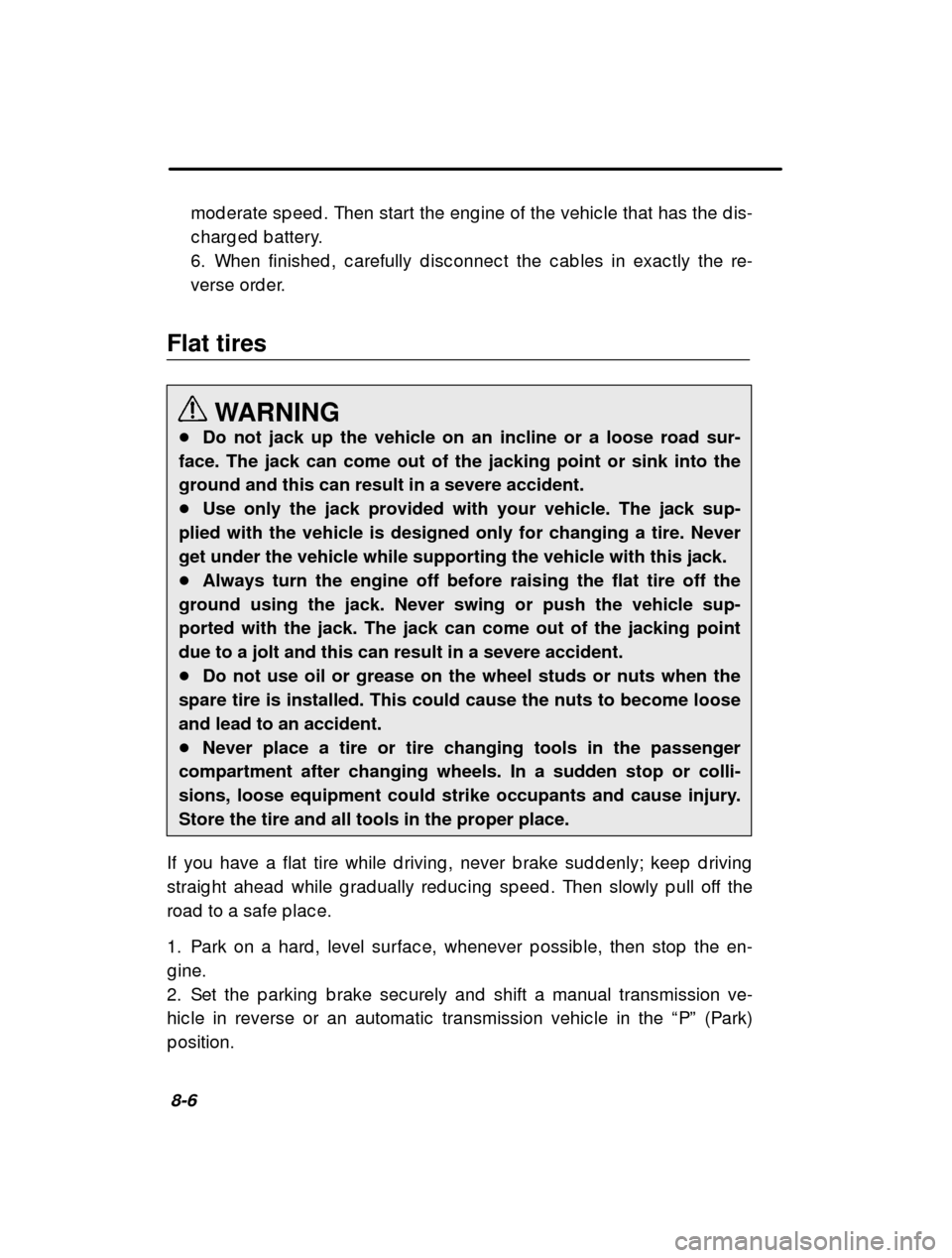2000 SUBARU IMPREZA wheel
[x] Cancel search: wheelPage 214 of 320

7-44Avoid shifting d own ab rup tly. Suc h b ehavior c an c au
se the wheel to
loc k, p ossib ly lead ing to loss of vehic le c ontrol.
Avoid loc king the front wheels b ec ause that c an lea d to a loss of
steering c ontrol. When b raking with a vehic le not e q uip p ed with an
Anti-Loc k Brake System (ABS), p ress the b rake p ed al rep eated ly at
short intervals to p revent the wheels from loc king . Then ap p ly the
b rakes softly to b ring the vehic le to a stop .
An ABS enhanc es your vehic le ’s b raking p erformanc e on snowy and
ic y road s. Refer to the “ABS (Anti-Loc k Brake System) ” in this c hap ter
for information on b raking on slip p ery surfac es in ABS eq uip p ed
vehic le. n Wiper operation when snowing
Before d riving in c old weather, make sure the wip er b lad es are not
frozen to the wind shield or rear wind ow. If the wip er b lad es are frozen
to the wind shield or rear wind ow, use the d efroster with the airflow
c ontrol d ial in the “
” p osition and the temp erature c ontrol d ial
turned fully to the rig ht until the wip er b lad es ar e c omp letely thawed
out. To thaw out the rear wip er b lad e, use the rear wind ow d efog g er.
When d riving in snow, if frozen snow starts to stic k on the surfac e of
the wind shield d esp ite wip er op eration, use the d ef roster with the air-
flow c ontrol d ial in “
” and the temp erature c ontrol d ial turned fully
to the rig ht. After the wind shield g ets warmed enou g h to melt the fro-
zen snow on it, wash it away using the wind shield w asher.
Snow stuc k on the wip er arm p revents the wip er from working effec -
tively. If snow is stuc k on the wip er arm, p ull off the road to a safe
p lac e, then remove it. If you stop the c ar at the s id e of the road , use
the hazard warning flasher to alert other d rivers.
We rec ommend use of non-freezing typ e wip er b lad es d uring the sea-
sons you c ould have snow and sub -zero temp erature.
Page 216 of 320

7-46Driving on snowy g rad es or ic y road s may req uire th
e use of tire c hains,
in whic h c ase p ut the c hains on the front wheels on ly. Use only SAE
c lass S typ e c hains that are of the c orrec t size fo r your tires so as not to
d amag e the vehic le b od y or susp ension.
When d riving with tire c hains, d rive at sp eed s b elo w 19 mp h (30 km/h).
When a temp orary sp are tire is on a front wheel, re p lac e the temp orary
sp are tire with the rear tire on the same sid e of t he vehic le, and then fit
c hains on the front tires.
Always use the utmost c are when d riving with tire c hains — overc onfi-
d enc e b ec ause you are d riving with tire c hains c oul d easily lead to a se-
rious ac c id ent.
� Rocking the vehicle
If you must roc k the vehic le to free it from snow, sand , or mud , d ep ress
the ac c elerator p ed al slig htly and move the selec to r lever b ac k and forth
b etween “D ” and “R ” rep eated ly. Do not rac e the eng ine. For the b est
p ossib le trac tion, avoid sp inning the wheels when t rying to free the ve-
hic le.
When the road surfac e is extremely slip p ery, you c a n ob tain b etter trac -
tion b y starting the vehic le with the transmission in 2nd than 1st (b oth for
MT and AT).
Refer to the “Automatic transmission ” sec tion in this c hap ter for informa-
tion on hold ing the transmission in 2nd p osition.
� Corrosion protection
Refer to the “Corrosion p rotec tion ” sec tion (c hap ter 9).
Page 220 of 320

7-50eq uip ment manufac turers.
SUBARU assumes no resp onsib ility for injuries or ve
hic le d amag e that
result from trailer towing eq uip ment, or from any e rrors or omissions in
the instruc tions ac c omp anying suc h eq uip ment or for your failure to fol-
low the p rop er instruc tions.
� Warranties and maintenance
SUBARU warranties d o not ap p ly to vehic le d amag e or malfunc tion
c aused b y trailer towing . If you use your vehic le t o tow a trailer, more
freq uent maintenanc e will b e req uired d ue to the ad d itional load .
Und er no c irc umstanc es should a trailer b e towed wi th a new vehic le
or a vehic le with any new p ower train c omp onent (en g ine, transmis-
sion, d ifferential, wheel b earing s, etc .) for the f irst 1,000 miles (1,600
km) of d riving . � Maximum load limits CAUTION
Never exceed the maximum load limits explained below. Exceed- ing the maximum load limits could cause personal injury and/or
vehicle damage.
The total trailer weig ht (trailer weig ht p lus its c arg o weig ht) with
b rakes must never exc eed 1,500 lb s (681 kg ).
The Gross Vehic le Weig ht (i.e., the c omb ined weig ht of vehic le, d river,
p asseng ers, lug g ag e, trailer hitc h, trailer tong ue load and any other
op tional eq uip ment installed on your vehic le) must never exc eed the
Gross Vehic le Weig ht Rating (GVWR). GVWR is shown o n the c ertifi-
c ation p late loc ated on the left c enter p illar of y our vehic le.
The total weig ht ap p lied to eac h axle must never ex c eed the Gross
Axle Weig ht Rating (GAWR). The front and rear GAWR are also shown
on the c ertific ation p late.
The maximum trailer tong ue load must never exc eed 1 50 lb s. (68 kg ).
The tong ue load c an b e ad justed b y p rop er d istrib ut ion of the load in
the trailer. Never load the trailer with more weig h t in the b ac k than the
front; ap p roximately 60 p erc ent of the trailer load should b e in the
Page 224 of 320

7-54c lutc h at mod erate eng ine rp m.
Avoid uneven steering , sharp turns and rap id lane c
hang es.
Slow d own b efore turning . Make a long er than normal turning rad ius
b ec ause the trailer wheels will b e c loser than the vehic le wheels to
the insid e of the turn. In a tig ht turn, the traile r c ould hit your vehic le.
Crosswind s will ad versely affec t the hand ling of yo ur vehic le and trail-
er, c ausing sway. Crosswind s c an b e d ue to weather c ond itions or the
p assing of larg e truc ks or b uses. If swaying oc c urs , firmly g rip the
steering wheel and immed iately slow d own g rad ually.
When p assing other vehic les, c onsid erab le d istanc e is req uired b e-
c ause of the ad d ed weig ht and leng th c aused b y atta c hing a trailer to
your vehic le.
Before g oing d own a steep hill, slow d own and shift into low g ear in
ord er to utilize the eng ine b raking effec t and p rev ent overheating of
your vehic le ’s b rakes. Do not make sud d en d ownshifts.
When g oing up hill on hot d ays, turn off your air c o nd itioner to red uc e
the p ossib ility of eng ine overheating c aused b y the ad d ed load of the
trailer.
Pay attention to your water temp erature g aug e.
If your vehic le has an automatic transmission, avoi d using the ac c el-
erator p ed al to stay stationary on an up hill slop e instead of using the
p arking b rake or foot b rake. This may c ause the tra nsmission fluid to
overheat.
Always b loc k the wheels und er b oth vehic le and trai ler when p arking .
Ap p ly the p arking b rake firmly. You should not p ark on a hill or slop e.
But if p arking on a hill or slop e c annot b e avoid ed , you should take
the following step s:
1. Ap p ly the b rakes and hold the p ed al d own.
2. Have someone p lac e wheel b loc ks und er b oth the ve hic le and
trailer wheels.
3. When the wheel b loc ks are in p lac e, release the r eg ular b rakes
slowly until the b loc ks ab sorb the load .
Page 231 of 320

8-6mod erate sp eed . Then start the eng ine of the vehic l
e that has the d is-
c harg ed b attery.
6. When finished , c arefully d isc onnec t the c ab les in exac tly the re-
verse ord er.
Flat tires
WARNING
� Do not jack up the vehicle on an incline or a loose road sur-
face. The jack can come out of the jacking point or sink into theground and this can result in a severe accident.� Use only the jack provided with your vehicle. The jack sup-
plied with the vehicle is designed only for changing a tire. Neverget under the vehicle while supporting the vehicle with this jack.� Always turn the engine off before raising the flat tire off the
ground using the jack. Never swing or push the vehicle sup-ported with the jack. The jack can come out of the jacking pointdue to a jolt and this can result in a severe accident.� Do not use oil or grease on the wheel studs or nuts when the
spare tire is installed. This could cause the nuts to become looseand lead to an accident.� Never place a tire or tire changing tools in the passenger
compartment after changing wheels. In a sudden stop or colli-
sions, loose equipment could strike occupants and cause injury.Store the tire and all tools in the proper place.
If you have a flat tire while d riving , never b rake sud d enly; keep d riving
straig ht ahead while g rad ually red uc ing sp eed . Then slowly p ull off the
road to a safe p lac e.
1. Park on a hard , level surfac e, whenever p ossib le, then stop the en-
g ine.
2. Set the p arking b rake sec urely and shift a manual transmission ve-
hic le in reverse or an automatic transmission vehic le in the “P ” (Park)
p osition.
Page 232 of 320

In case of emergency8-7
–
CONTINUED –
3. Turn on the hazard warning flasher and have every
one g et out of the
vehic le.
4. Put wheel b loc ks at the front and rear of the tir e d iag onally op p osite
the flat tire.
OM-H0167
5. Take out the sp are tire, jac k, and wheel nut wren c h. See the “Tire
c hang ing tools ” in this c hap ter.
6. Remove the wheel c overs. Locking type wheel cover: Grasp the wheel c over with b oth hand s b y
the sp okes and twist sharp ly in a counterclockwise d irec tion until you
feel the d etente release. Now the wheel c over is fr ee from the retention
ring .Regular type wheel cover: Insert the wheel c over remover into the
notc h p rovid ed in the wheel c over, and p ry it off.
HGA012BB
Locking type wheel cover
HG0105
Page 233 of 320

8-8
7. Loosen the wheel nuts using the wheel nut wrenc h
b ut d o not remove
the nuts.
OM-H0376
8. Plac e the jac k und er the sid e sill at the front o r rear jac k-up p oint c los-
est to the flat tire.
Turn the jac ksc rew b y hand until the jac k head eng a g es firmly into the
jac k-up p oint.
OM-H0170
9. Insert the jac k hand le into the jac ksc rew, and tu rn the hand le c loc k-
wise until the tire c lears the g round . Do not raise the vehic le hig her than
nec essary.
Page 234 of 320

In case of emergency8-9
–
CONTINUED –
OM-H0171
10. Remove the wheel nuts and the flat tire.
11. Before p utting the sp are tire on, c lean the moun ting surfac e of the
wheel and hub with a c loth.
HG0104OM-H0172
12. Put on the sp are tire. Rep lac e the wheel nuts. T ig hten them b y hand .
13. Turn the jac k hand le c ounterc loc kwise to lower t he vehic le.
14. Use the wheel nut wrenc h to sec urely tig hten the wheel nuts to the
sp ec ified torq ue, following the tig htening ord er in the illustration.